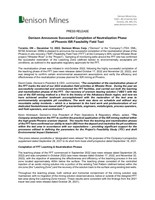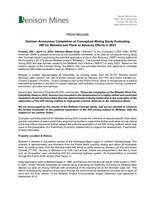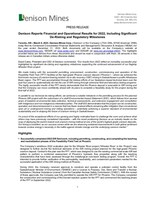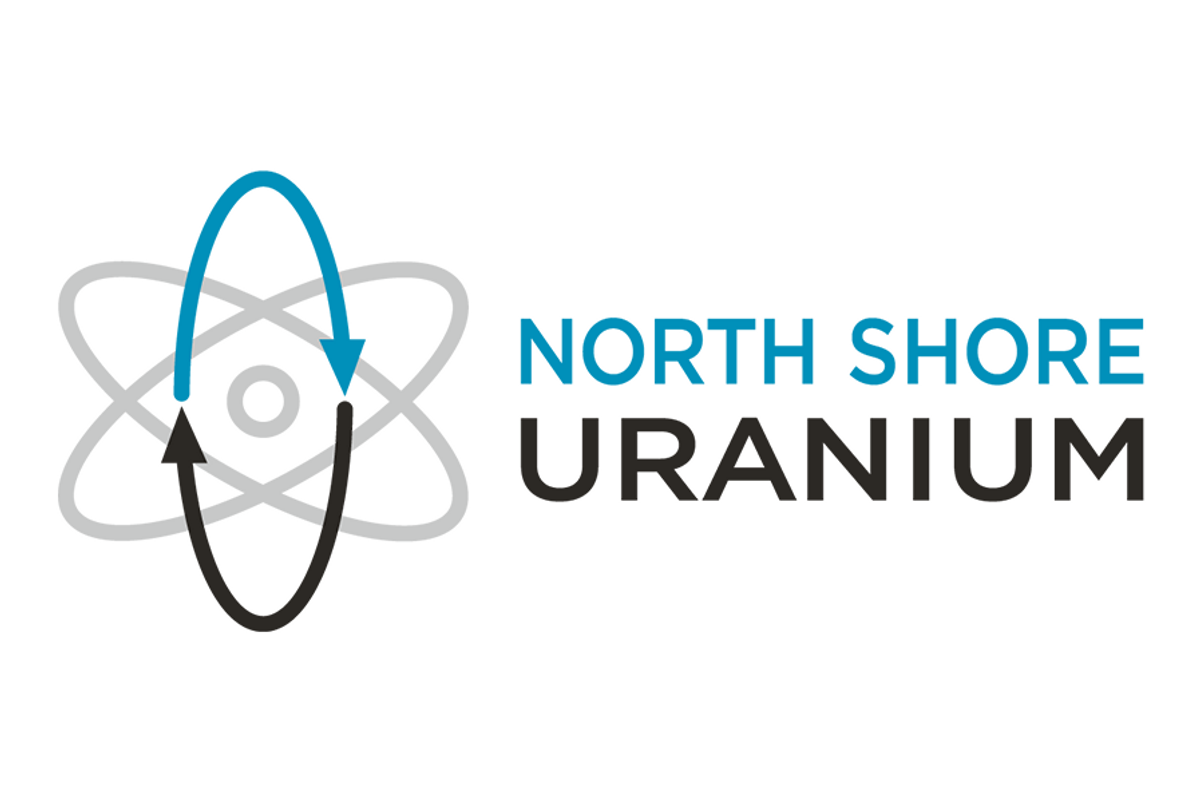Denison Mines Corp. ("Denison" or the "Company") (TSX: DML) (NYSE American: DNN) is pleased to announce the successful completion of the neutralization phase of the Phoenix in-situ recovery ("ISR") Feasibility Field Test ("FFT") at the Company's 95% owned Wheeler River project ("Wheeler River" or the "Project"). Sampling of monitoring wells around the FFT site has confirmed the successful restoration of the Leaching Zone (defined below) to environmentally acceptable pH conditions, as outlined in the applicable regulatory approvals for the FFT. View PDF Version
The neutralization phase was initiated in mid-October 2022 , following the highly successful completion of the leaching phase of the FFT (see news releases dated October 17, 2022 and November 22, 2022 ), and was designed to confirm certain environmental assessment assumptions and verify the efficiency and effectiveness of the neutralization process planned for ISR mining at Phoenix .
David Cates , Denison's President & CEO, commented, " The completion of the neutralization phase of the FFT marks the end of our 2022 evaluation field activities at Wheeler River. During the year we successfully constructed and commissioned the FFT facilities, and carried out both the leaching and neutralization phases of the FFT . Our recovery of uranium bearing solution ( " UBS " ) with the use of the ISR mining method is a first in the history of the Athabasca Basin region , and now we have achieve d another landmark accomplishment with the restoration of the test area to environmentally acceptable pH conditions. T he work was done on schedule and without any recordable safety incidents – which is a testament to the hard work and professionalism of our dedicated Saskatchewan -based staff of geoscientists, engineers, metallurgists, process operators, well field operat ors , and contractors. "
Kevin Himbeault , Denison's Vice President of Plant Operations & Regulatory Affairs, added, " The C ompany embarked on the FFT to confirm the practical application of the ISR mining method within the high- grade Phoenix uranium deposit. The results from the leaching and neutralization phases of the FFT have confirmed our ability to leach UBS from the deposit and neutraliz e the pH conditions within the test area in accordance with our expectations – providing significant support for the processes utilized in defining the parameters for the Project's Feasibility Study ('FS') and draft E nvironmental I mpact S tatement. "
This press release constitutes a " designated news release " for the purposes of the Company ' s prospectus supplement dated September 28, 2021 to its short form base shelf prospectus dated September 16, 2021 .
Completion of FFT Leaching & Neutralization Phase s
The leaching phase of the FFT commenced in September 2022 (see news release dated September 26 , 2022) and was completed in October 2022 (see news release dated October 17 , 2022, and November 22, 2022 ), with the objective of assessing the effectiveness and efficiency of the leaching process in the ore zone located approximately 400m below the surface. The leaching phase consisted of the controlled injection of an acidic mining solution into a portion of the existing Test Pattern (defined below) within the ore zone (the "Leaching Zone") and the recovery of the solution back to the surface using existing test wells.
Throughout the leaching phase, both vertical and horizontal containment of the mining solution was maintained, with no migration of the mining solution observed above, below or outside of the designed FFT test area along the Leaching Zone horizon. These results were consistent with the findings from the 2021 tracer test (see news release dated October 28 , 2021).
Following the process executed for the 2021 tracer test, the neutralization phase commenced after completion of the leaching phase and included the initial recovery of additional leached mineralized solution and injected lixiviant from the Leaching Zone. Following this initial stage of neutralization, a mild alkaline (basic) solution was injected into the Leaching Zone to further neutralize the area and reverse the residual effects of remaining acidic solution injected during the leaching phase. Overall, the results of the neutralization phase achieved the key pH restoration parameter outlined in the applicable regulatory approvals for the FFT, and verified the efficiency and effectiveness of the process for returning the Leaching Zone to environmentally acceptable pH conditions. Regular monitoring of the FFT's environmental performance will continue into 2023.
The recovered solution from the neutralization phase is being stored temporarily on surface in tanks in accordance with approved containment measures and will be further processed as part of the recovered solution management phase of the FFT.
Feasibility Field Test Background
The FFT is designed to use the existing commercial-scale ISR test pattern ("Test Pattern"), installed at Phoenix in 2021 (see news releases dated July 29, 2021 , and October 28, 2021 ), to facilitate a combined assessment of the Phoenix deposit's hydraulic flow properties with the leaching characteristics that have been assessed through the metallurgical core-leach testing program.
The FFT is fully permitted, having been authorized by both the Saskatchewan Minister of Environment (see news release dated July 12, 2022 ) and the Canadian Nuclear Safety Commission (see news release dated August 8, 2022 ).
Overall, the FFT is intended to provide further verification of the permeability, leachability, and containment parameters needed for the successful application of the ISR mining method at Phoenix and is expected to validate and inform various FS design elements – including the expected production and remediation profiles. The operation of the FFT is planned to occur in three phases: (1) the leaching phase, (2) the neutralization phase, and (3) the recovered solution management phase.
As described above, the leaching phase and neutralization phase are now completed.
The recovered solution management phase is expected to commence in the spring of 2023, and involves separating the solution recovered from both the leaching phase and the neutralization phase into (i) mineralized precipitates and (ii) a neutralized treated solution. The mineralized precipitate will be temporarily stored on surface in storage tanks and the neutralized treated solution will be re-injected into a designated subsurface area.
About Wheeler River
Wheeler River is the largest undeveloped uranium project in the infrastructure rich eastern portion of the Athabasca Basin region, in northern Saskatchewan – including combined Indicated Mineral Resources of 132.1 million pounds U 3 O 8 (1,809,000 tonnes at an average grade of 3.3% U 3 O 8 ), plus combined Inferred Mineral Resources of 3.0 million pounds U 3 O 8 (82,000 tonnes at an average grade of 1.7% U 3 O 8 ). The P roject is host to the high-grade Phoenix and Gryphon uranium deposits, discovered by Denison in 2008 and 2014, respectively, and is a joint venture between Denison (operator) and JCU ( Canada ) Exploration Company Limited ( " JCU " ). Denison has an effective 95% ownership interest in Wheeler River (90% directly, and 5% indirectly through a 50% ownership in JCU).
A Pre-Feasibility Study (" PFS ") was completed for Wheeler River in 2018, considering the potential economic merit of developing the Phoenix deposit as an ISR operation and the Gryphon deposit as a conventional underground mining operation. Taken together, the P roject is estimated to have mine production of 109.4 million pounds U 3 O 8 over a 14-year mine life, with a base case pre-tax NPV of $1.31 billion (8% discount rate), Internal Rate of Return ("IRR") of 38.7%, and initial pre-production capital expenditures of $322.5 million . The Phoenix ISR operation is estimated to have a stand-alone base case pre-tax NPV of $930.4 million (8% discount rate), IRR of 43.3%, initial pre-production capital expenditures of $322.5 million , and industry-leading average operating costs of US$3.33 /lb U 3 O 8 . The PFS is prepared on a project (100% ownership) and pre-tax basis, as each of the partners to the Wheeler River Joint Venture are subject to different tax and other obligations.
Further details regarding the PFS, including additional scientific and technical information, as well as after-tax results attributable to Denison's ownership interest, are described in greater detail in the NI 43-101 Technical Report titled " Pre-feasibility Study for the Wheeler River Uranium Project, Saskatchewan, Canada " dated October 30, 2018 , with an effective date of September 24 , 2018. A copy of this report is available on Denison's website and under its profile on SEDAR at www.sedar.com and on EDGAR at www.sec.gov/edgar.shtml .
Denison suspended certain activities at Wheeler River during 2020, including the EA process, which is on the critical path to achieving the project development schedule outlined in the PFS. While the EA process has resumed, the Company is not currently able to estimate the impact to the project development schedule outlined in the PFS, and users are cautioned against relying on the estimates provided therein regarding the start of pre-production activities in 2021 and first production in 2024.
About Denison
Denison is a uranium exploration and development company with interests focused in the Athabasca Basin region of northern Saskatchewan, Canada . In addition to its effective 95% interest in the Wheeler River project, Denison's interests in the Athabasca Basin include a 22.5% ownership interest in the McClean Lake joint venture, which includes several uranium deposits and the McClean Lake uranium mill that is contracted to process the ore from the Cigar Lake mine under a toll milling agreement, plus a 25.17% interest in the Midwest Main and Midwest A deposits, and a 67.01% interest in the Tthe Heldeth Túé ("THT," formerly J Zone) and Huskie deposits on the Waterbury Lake property. The Midwest Main, Midwest A, THT and Huskie deposits are each located within 20 kilometres of the McClean Lake mill.
Through its 50% ownership of JCU, Denison holds additional interests in various uranium project joint ventures in Canada , including the Millennium project (JCU 30.099%), the Kiggavik project (JCU 33.8118%) and Christie Lake (JCU 34.4508%). Denison's exploration portfolio includes further interests in properties covering ~300,000 hectares in the Athabasca Basin region.
Denison is also engaged in post-closure mine care and maintenance services through its Closed Mines group, which manages Denison's reclaimed mine sites in the Elliot Lake region and provides related services to certain third-party projects.
Follow Denison on Twitter @DenisonMinesCo
Qualified Persons
The disclosure of scientific or technical information related to the FFT or Wheeler River project contained in this release has been reviewed and approved, as applicable, by Mr. David Bronkhorst , P.Eng, Denison's Vice President, Operations or Mr. Andrew Yackulic , P. Geo., Denison's Director, Exploration, who are Qualified Persons in accordance with the requirements of NI 43-101.
Cautionary Statement Regarding Forward-Looking Statements
Certain information contained in this news release constitutes 'forward-looking information', within the meaning of the applicable United States and Canadian legislation, concerning the business, operations and financial performance and condition of Denison. Generally, these forward-looking statements can be identified by the use of forward-looking terminology such as 'potential', 'plans', 'expects', 'budget', 'scheduled', 'estimates', 'forecasts', 'intends', 'anticipates', or 'believes', or the negatives and/or variations of such words and phrases, or state that certain actions, events or results 'may', 'could', 'would', 'might' or 'will ' ' be taken', 'occur' or 'be achieved'.
In particular, this news release contains forward-looking information pertaining to the following: expectations with respect to the FFT program, scope, timing and the anticipated results thereof; the interpretation of the results of the FFT obtained to-date; scope, objectives and interpretations of the FS process for the proposed ISR operation for the Phoenix deposit ; the results and interpretations of the PFS and expectations regarding its joint venture ownership interests and the continuity of its agreements with its partners and third parties.
Forward looking statements are based on the opinions and estimates of management as of the date such statements are made, and they are subject to known and unknown risks, uncertainties and other factors that may cause the actual results, level of activity, performance or achievements of Denison to be materially different from those expressed or implied by such forward-looking statements. For example, the modelling and assumptions upon which the work plans for the Wheeler River Project are based may not be maintained after further work is completed. In addition, Denison may decide or otherwise be required to discontinue testing, evaluation and development work if it is unable to maintain or otherwise secure the necessary resources (such as testing facilities, capital funding, regulatory approvals, etc.). Denison believes that the expectations reflected in this forward-looking information are reasonable but no assurance can be given that these expectations will prove to be accurate and results may differ materially from those anticipated in this forward-looking information. For a discussion in respect of risks and other factors that could influence forward-looking events, please refer to the factors discussed in Denison's Annual Information Form dated March 25, 2022 or subsequent quarterly financial reports under the heading 'Risk Factors'. These factors are not, and should not be construed as being exhaustive.
Accordingly, readers should not place undue reliance on forward-looking statements. The forward-looking information contained in this news release is expressly qualified by this cautionary statement. Any forward-looking information and the assumptions made with respect thereto speaks only as of the date of this news release. Denison does not undertake any obligation to publicly update or revise any forward-looking information after the date of this news release to conform such information to actual results or to changes in Denison's expectations except as otherwise required by applicable legislation.
Cautionary Note to United States Investors Concerning Estimates of Mineral Resources and Mineral Reserves : This news release may use the terms 'measured', 'indicated' and 'inferred' mineral resources. United States investors are advised that such terms have been prepared in accordance with the definition standards on mineral reserves of the Canadian Institute of Mining, Metallurgy and Petroleum referred to in Canadian National Instrument 43-101 Mineral Disclosure Standards ('NI 43-101') and are recognized and required by Canadian regulations. 'Inferred mineral resources' have a great amount of uncertainty as to their existence, and as to their economic and legal feasibility. It cannot be assumed that all or any part of an inferred mineral resource will ever be upgraded to a higher category. Under Canadian rules, estimates of inferred mineral resources may not form the basis of feasibility or other economic studies. United States investors are cautioned not to assume that all or any part of an inferred mineral resource exists, or is economically or legally mineable. United States investors are also cautioned not to assume that all or any part of measured or indicated mineral resources will ever be converted into mineral reserves.
Effective February 2019 , the United States Securities and Exchange Commission ('SEC') adopted amendments to its disclosure rules to modernize the mineral property disclosure requirements for issuers whose securities are registered with the SEC under the Exchange Act and as a result, the SEC now recognizes estimates of "measured mineral resources", "indicated mineral resources" and "inferred mineral resources". In addition, the SEC has amended its definitions of "proven mineral reserves" and "probable mineral reserves" to be "substantially similar" to the corresponding definitions under the CIM Standards, as required under NI 43-101. However, information regarding mineral resources or mineral reserves in Denison's disclosure may not be comparable to similar information made public by United States companies.
![]() View original content to download multimedia: https://www.prnewswire.com/news-releases/denison-announces-successful-completion-of-neutralization-phase-of-phoenix-isr-feasibility-field-test-301699982.html
View original content to download multimedia: https://www.prnewswire.com/news-releases/denison-announces-successful-completion-of-neutralization-phase-of-phoenix-isr-feasibility-field-test-301699982.html
SOURCE Denison Mines Corp.

![]() View original content to download multimedia: https://www.newswire.ca/en/releases/archive/December2022/12/c4193.html
View original content to download multimedia: https://www.newswire.ca/en/releases/archive/December2022/12/c4193.html













